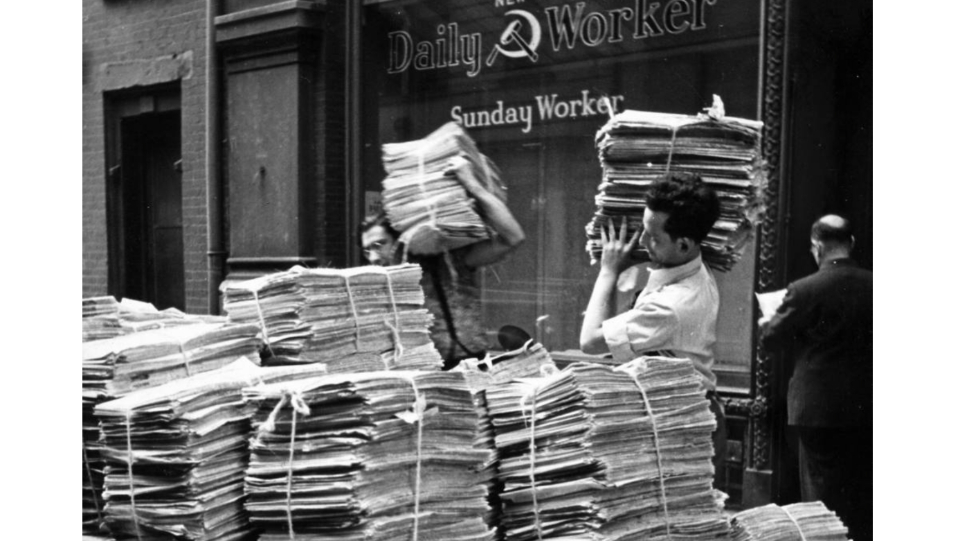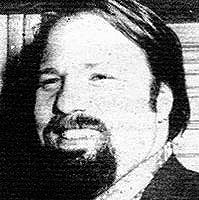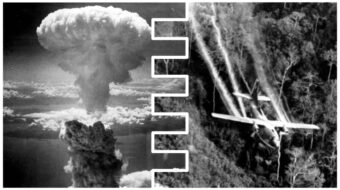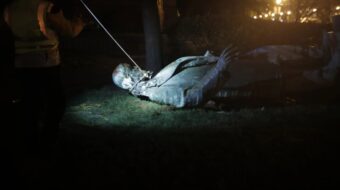
The following is an interview conducted in January 1984 with Art Shields (1888-1988), then aged 95, a veteran labor journalist who was on the original staff of the Daily Worker (predecessor of People’s World) when it rolled off the presses for the first time on January 13, 1924. The interview was conducted by Mike Zagarell, then the editor of the Daily World. It was originally published in Daily World on January 12, 1984.
Mike Zagarell: Art, you worked on the Daily Worker the day it put out its historic first edition. What was it like then?
Art Shields: Well, we had a very small office on West Washington Boulevard in Chicago. We kept that for only a couple of months and then moved to a better place on Western Boulevard. The newsroom was about the size of this room in which we are sitting (About 10 ft. by 14 ft.)
There were two co-editors, Louis Engdahl and Bob Dunn—theoretically of equal authority—representing two different trends in the Communist Party at that time. One trend was led by Charles Ruthenberg, the other by William Z. Foster. Engdahl actually was the leading editor. He represented the Ruthenberg group, but there was no factionalism in the paper that I can recall.
I remember the paper was hammering on the national political scene. The expose of the Ohio Gang (Detroit-based monopolists) was developing then. Bob Minor and Freddy Ellis, our two cartoonists, were strong on that. Both of them had the ability to show the strength of the working class.

What was that first day like for you?
It was very pleasant. I liked it better than the atmosphere on the IWW (Industrial Workers of the World) paper. I edited the Wobbly paper for some months in 1921. The Communist Party was full of confidence in the future. Engdahl breathed confidence. He was an excellent newspaperman. He had seven years of experience. He had been editor of the Chicago Daily Socialist, a paper that flourished for some years at the end of the first decade of the century.
Anyway, that first day, Louis Engdahl called us together in rather a matter-of-fact way. We had a short meeting and arranged what every person was to do. My job was an inside job that first day, rewriting copy that came in from party districts. We got a lot of our national news from party comrades, many in the industrial cities. It needed a lot of rewriting, though, and I used to do that.
Did you say he called you all together in a “matter-of-fact” way?
He didn’t make a big speech about it. He said that we’re starting something here that isn’t just going to be finished. This paper is going to stay. And we want to get out a very good first issue. That’s all I remember. It was a very good little talk for the purpose. We go to work right away. There was a mountain of copy for me, I remember.

Was that a long day’s work?
Yes. There were big editorials and some long articles on the national situation. And there was a drawing by Bob Minor.
How did you decide what the drawing would be about? Was that discussed in the morning meeting?
Well, no. We had nothing to do with the drawings. They were simply done well—and all you could do was admire them, really. Fred Ellis was the paper’s cartoonist until he died at the end of the ’50s. He had been a sign painter in Chicago. He got his first labor ideas working as a laborer in the Chicago stockyards.
What were the members of the staff like?
I remember Bob Dunn, the other editor. He was a colorful person. He has a most dramatic background. He had been the editor in Butte, Montana, of a daily paper called The Bulletin, which was very defiant of the Anaconda Copper Company. There was a sign across the door saying that any gunmen who invaded the paper would be shot dead. They had armed guards there.
We also had an Irish columnist, Tom O’Flaherty. He wrote a humor column and some editorials. We had another reporter, who was a very good reporter, but didn’t have the Communist Party spirit and dropped out after a few months.
Then we had Carl Reeve. He wrote a number of memorable exposés. Once he got a job at Western Electric, controlled by AT&T, the telephone monopoly. They had a giant, non-union plant at Cicero, a suburb of Chicago. Carl was promoted to supervisor within a couple of days. He didn’t stay long—he simply couldn’t stand it—but he wrote several very beautiful stories from the inside.
This article was published in 2019 as part of the People’s World series: 100 Years of the Communist Party USA. Read the other articles published in the series.
Who else was on the staff?
Esther Julia Lowell (later to become Shields’s wife—MZ) joined the staff after two or three months and handled some of the foreign news. We wrote a lot about Mussolini, who at that time was consolidating his power. She got her stories by interviewing Italian émigrés, who were also Communist Party members. Because we had no direct connections, we had to pick up our foreign news in indirect ways sometimes. We had no news services.
There were seven people on the staff; or often only five, sometimes four; and on some days, there were only three of us getting out a six-page paper.
Who else was on the paper?
We had a circulation manager. He was from the west coast of Ireland, where he had been a fisherman. During the very first days, he was almost murdered. The Daily Worker was barred from the newsstands by gangsters, who controlled the newsstands in Chicago. These gangsters belonged to an AFL union, the Newsboys Union. They had a rather bloody record. These guys were armed. Our circulation manager went up a flight of stairs to the Newsboys Union. Someone pulled a pistol. He leaped out the door, and as he was flying down the stairs, a bullet went past his head.
What kind of a person was Robert Minor?
Oh, a marvelous person. I loved that man. He was very kind. I remember he and I covered a congress of Black organizations, which included Communist Party-led organizations. A delightful person to work with. He wrote as well as drew. Unfortunately, he gave up his drawing a few years later.
Someone told me he used to make notes for speeches in cartoons.
He did that, and he would also make notes with three different colored pencils. Certain things he would put in one color, some in another. The colors meant something to him.
Did you see the first edition come off the press?
Yes, we all stayed there when it came off the press. After that, I went out for dinner with Bill Dunn. We had quite a time of it, I remember. We were very proud of it, and happy.
How was the paper distributed in Chicago that day, if it didn’t go on newsstands?
We had a lot of people scurrying around. A lot of youngsters went out with bundles. But mainly the papers went out into the Communist Party districts around the country.
How much attention did the party give to building circulation of the newborn paper?
Well, I think in the beginning the party paid a great deal of attention. When the paper first started, it was a big thing for the party. I remember there were a lot of letters on that first edition. People were very excited about it. The party at that time had many foreign language papers, dailies—Finnish, German, and what-not. They publicized the Daily Worker in every edition. The party’s leader, C.E. Ruthenberg, urged them to do it.
When you first began working for the Daily Worker, how did you think things would turn out?
We all had lots of confidence. We all thought the paper would get a lot stronger, as it did. Louis Engdahl was especially confident.
To be truthful, we all expected everything to go a lot faster, but of course, there were a lot of difficult problems. We all know that socialism is coming, but history doesn’t always move at the pace you want. But I am still confident—and also a bit more patient.










